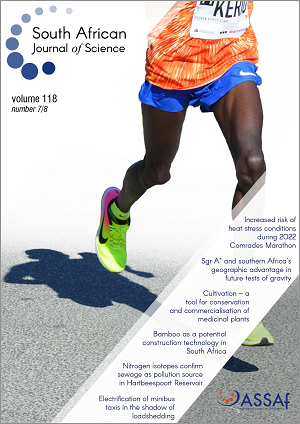Biomass conversion into recyclable strong materials
DOI:
https://doi.org/10.17159/sajs.2022/9747Keywords:
recycling, biomass, lignocellulose, bagasse, plastic, softwood, celluloseAbstract
We review the conversion of waste biomass into recyclable materials using different methods of materials treatment such as thermal, mechanical and chemical processes. Renewable and sustainable biomaterials are increasingly becoming alternatives for synthetic strong materials, e.g. composites. The type of treatment of biomaterial will determine the form to which the biomass is converted and its subsequent applications. It is anticipated that the transformation will produce materials that have superior qualities, properties and characteristics. These include biopolymer materials such as cellulose and hemicellulose, which have all been obtained as products of treatment and extraction from plant materials such as lignocellulose. The main reason for inefficient biomass conversion has been found to be poor manipulation of composite properties during biomass treatment process. The treatment processes are expected to facilitate dehydration, dehydrogenation, deoxygenation and decarboxylation of the bulk biomass materials to target the formation of new compounds that may be used to make strong materials.
Significance:
This work demonstrates that plant material, as a solid-state biomass material for strong structural applications such as in biocomposites, is affected by factors that include the alignment of fibres, orientation of fibres, and mass density distribution. However, biocomposite materials have been found to be non-toxic, corrosionresistant, low-cost, and renewable. They are preferred because the materials possess high thermal stability, are biodegradable and recyclable, and have high biocompatibility, performance, strength, water-resistance, specific surface area and aspect ratio to qualify them for applications including biobricks for construction, slabs for paving, vehicle internal components, ultra-high temperature aerospace ceramics, and energy storage devices.
Published
Issue
Section
License

All articles are published under a Creative Commons Attribution 4.0 International Licence
Copyright is retained by the authors. Readers are welcome to reproduce, share and adapt the content without permission provided the source is attributed.
Disclaimer: The publisher and editors accept no responsibility for statements made by the authors
How to Cite
- Abstract 538
- PDF 618
- EPUB 196
- XML 320
Funding data
-
Horizon 2020
Grant numbers 870292












.png)